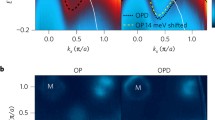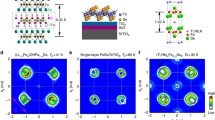Stewart, G. R. Superconductivity in iron compounds. Rev. Mod. Phys. 83, 1589–1652 (2011).
Article
ADS
Google Scholar
Paglione, J. & Greene, R. L. High-temperature superconductivity in iron-based materials. Nat. Phys. 6, 645–658 (2010).
Article
Google Scholar
Gao, M., Ma, F., Lu, Z.-Y. & **ang, T. Surface structures of ternary iron arsenides AFe2As2 (A=Ba, Sr, or Ca). Phys. Rev. B 81, 193409 (2010).
Article
ADS
Google Scholar
Nascimento, V. B. et al. Surface geometric and electronic structure of BaFe2As2(001). Phys. Rev. Lett. 103, 076104 (2009).
Article
ADS
Google Scholar
Yin, J.-X. et al. Orbital selectivity of layer-resolved tunneling in the iron-based superconductor Ba0.6K0.4Fe2As2. Phys. Rev. B 102, 054515 (2020).
Article
ADS
Google Scholar
Niestemski, F. C. et al. Unveiling the atomic and electronic structure at the surface of the parent pnictide SrFe2As2. Preprint at https://arxiv.org/abs/0906.2761 (2009).
Li, A. et al. Surface terminations and layer-resolved spectroscopy in 122 iron pnictide superconductors. Phys. Rev. B 99, 134520 (2019).
Article
ADS
Google Scholar
Richard, P., Sato, T., Nakayama, K., Takahashi, T. & Ding, H. Fe-based superconductors: an angle-resolved photoemission spectroscopy perspective. Rep. Prog. Phys. 74, 124512 (2011).
Article
ADS
Google Scholar
Ye, Z.-R., Zhang, Y., **e, B.-P. & Feng, D.-L. Angle-resolved photoemission spectroscopy study on iron-based superconductors. Chin. Phys. B 22, 087407 (2013).
Article
ADS
Google Scholar
Liu, C. et al. Surface-driven electronic structure in LaFeAsO studied by angle resolved photoemission spectroscopy. Phys. Rev. B 82, 075135 (2010).
Article
ADS
Google Scholar
Zhang, P. et al. Disentangling the surface and bulk electronic structures of LaOFeAs. Phys. Rev. B 94, 104517 (2016).
Article
ADS
Google Scholar
Yang, L. X. et al. Surface and bulk electronic structures of LaFeAsO studied by angle-resolved photoemission spectroscopy. Phys. Rev. B 82, 104519 (2010).
Article
ADS
Google Scholar
Pfau, H. et al. Detailed band structure of twinned and detwinned BaFe2As2 studied with angle-resolved photoemission spectroscopy. Phys. Rev. B 99, 035118 (2019).
Article
ADS
Google Scholar
Zhang, Y. et al. Orbital characters of bands in the iron-based superconductor BaFe1.85Co0.15As2. Phys. Rev. B 83, 054510 (2011).
Article
ADS
Google Scholar
Yi, M. et al. Symmetry-breaking orbital anisotropy observed for detwinned Ba(Fe1-xCox)As2 above the spin density wave transition. Proc. Natl Acad. Sci. USA 108, 6878–6883 (2011).
Article
ADS
Google Scholar
Terashima, K. et al. Fermi surface nesting induced strong pairing in iron-based superconductors. Proc. Natl Acad. Sci. USA 106, 7330–7333 (2009).
Article
ADS
Google Scholar
Ye, Z.-R. et al. Do** dependence of the electronic structure in phosphorus-doped ferropnictide superconductor BaFe2(As1−xPx)2 studied by angle-resolved photoemission spectroscopy. Phys. Rev. B 86, 035136 (2012).
Article
ADS
Google Scholar
Zhang, Y. et al. Nodal superconducting-gap structure in ferropnictide superconductor BaFe2(As0.7P0.3)2. Nat. Phys. 8, 371–375 (2012).
Article
Google Scholar
Ding, H. et al. Observation of Fermi-surface-dependent nodeless superconducting gaps in Ba0.6K0.4Fe2As2. Europhys. Lett. 83, 470031 (2008).
Article
Google Scholar
Nakayama, K. et al. Superconducting gap symmetry of Ba0.6K0.4Fe2As2 studied by angle-resolved photoemission spectroscopy. Europhys. Lett. 85, 67002 (2009).
Article
ADS
Google Scholar
Watson, M. D. et al. Evidence for unidirectional nematic bond ordering in FeSe. Phys. Rev. B 94, 201107 (2016).
Article
ADS
Google Scholar
Zhang, Y. et al. Distinctive momentum dependence of the band reconstruction in the nematic state of FeSe thin film. Phys. Rev. B 94, 115153 (2016).
Article
ADS
Google Scholar
Miao, H. et al. Isotropic superconducting gaps with enhanced pairing on electron Fermi surfaces in FeTe0.55Se0.45. Phys. Rev. B 85, 094506 (2012).
Article
ADS
Google Scholar
Borisenko, S. V. et al. Superconductivity without nesting in LiFeAs. Phys. Rev. Lett. 105, 067002 (2010).
Article
ADS
Google Scholar
Umezawa, K. et al. Unconventional anisotropic s-wave superconducting gaps of the LiFeAs iron-pnictide superconductor. Phys. Rev. Lett. 108, 037002 (2012).
Article
ADS
Google Scholar
Kasahara, S. et al. Evolution from non-Fermi- to Fermi-liquid transport via isovalent do** in BaFe2(As1−xPx)2 superconductors. Phys. Rev. B 81, 184519 (2010).
Article
ADS
Google Scholar
Walmsley, P. et al. Quasiparticle mass enhancement close to the quantum critical point in BaFe2(As1−xPx)2. Phys. Rev. Lett. 110, 257002 (2013).
Article
ADS
Google Scholar
Hirschfeld, P. J., Korshunov, M. M. & Mazin, I. I. Gap symmetry and structure of Fe-based superconductors. Rep. Prog. Phys. 74, 124508 (2011).
Article
ADS
Google Scholar
Wang, F. & Lee, D.-H. The electron-pairing mechanism of iron-based superconductors. Science 332, 200–204 (2011).
Article
ADS
Google Scholar
Dai, P., Hu, J. & Dagotto, E. Magnetism and its microscopic origin in iron-based high-temperature superconductors. Nat. Phys. 8, 709–718 (2012).
Article
Google Scholar
Mazin, I. I. & Schmalian, J. Pairing symmetry and pairing state in ferropnictides: theoretical overview. Physica C 469, 614–627 (2009).
Article
ADS
Google Scholar
Xu, Y.-M. et al. Observation of a ubiquitous three-dimensional superconducting gap function in optimally doped Ba0.6K0.4Fe2As2. Nat. Phys. 7, 198–202 (2011).
Article
Google Scholar
Zhang, Y. et al. Out-of-plane momentum and symmetry-dependent energy gap of the pnictide Ba0.6K0.4Fe2As2 superconductor revealed by angle-resolved photoemission spectroscopy. Phys. Rev. Lett. 105, 117003 (2010).
Article
ADS
Google Scholar
Shimojima, T. et al. Anomalous two peak structure in the angle-resolved photoemission spectra of Ba1-xKxFe2As2. Preprint at https://arxiv.org/abs/1206.3163 (2012).
Zhang, P. et al. Observation of momentum-confined in-gap impurity state in Ba0.6K0.4Fe2As2: evidence for anti-phase s± pairing. Phys. Rev. X 4, 031001 (2014).
Google Scholar
Yi, M. et al. Unconventional electronic reconstruction in undoped (Ba, Sr) Fe2 As2 across the spin density wave transition. Phys. Rev. B 80, 174510 (2009).
Article
ADS
Google Scholar
Zhang, Y. et al. Unusual do** dependence of the electronic structure and coexistence of spin-density-wave and superconductor phases in single crystalline Sr1-xKxFe2As2. Phys. Rev. Lett. 102, 127003 (2009).
Article
ADS
Google Scholar
Wang, Q. et al. Symmetry-broken electronic structure and uniaxial Fermi surface nesting of untwinned CaFe2As2. Phys. Rev. B 88, 235125 (2017).
Article
ADS
Google Scholar
Suzuki, K., Usui, H. & Kuroki, K. Possible three-dimensional nodes in the s± superconducting gap of BaFe2(As1-xPx)2. J. Phys. Soc. Jpn. 80, 013710 (2011).
Article
ADS
Google Scholar
Yoshida, T. et al. Two-dimensional and three-dimensional fermi surfaces of superconducting BaFe2(As1−xPx)2 and their nesting properties revealed by angle-resolved photoemission spectroscopy. Phys. Rev. Lett. 106, 117001 (2013).
Article
ADS
Google Scholar
Yoshida, T. et al. Anisotropy of the superconducting gap in the iron-based superconductor BaFe2(As0.7P0.3)2. Sci. Rep. 4, 7292 (2014).
Article
Google Scholar
Sprau, P. O. et al. Discovery of orbital-selective Cooper pairing in FeSe. Science 357, 75–80 (2017).
Article
ADS
Google Scholar
Kreisel, A. et al. Orbital selective pairing and gap structures of iron-based superconductors. Phys. Rev. B 95, 174504 (2017).
Article
ADS
Google Scholar
Nakajima, M. et al. Growth of BaFe2(As1-xPx)2 single crystals (0≤x≤1) by Ba2As3/Ba2P3-flux method. J. Phys. Soc. Jpn. 81, 104710 (2012).
Article
ADS
Google Scholar







